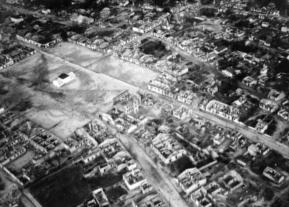


The Defence
Działoszyn - along with other border towns and villages - was the first line of defence against the invading German forces. On 1 September 1939 the town was bombed three times. The first bombing destroyed the town centre; the second raid, half an hour later, expanded the scale of destruction and caused numerous fires. The third air raid carried out by about 30 Luftwaffe Stuka dive bombers almost completely destroyed the town. There were many killed and severely injured, especially among the civilians, who hurriedly left the ruins. Only a few houses, the local post office and the bridge over the Warta River remained intact. The vast majority of the town’s civilian population left as refugees before and during the onslaught. Approximately 2,000 Jews were reported as going to the neighbouring town of Pajeczno. A number of Jews from Dzialoszyn were also found in Zelów (Lask county) in 1939 or 1940, and about 250 in Kielczyglów (Wieluń county). As for the refugees of Działoszyn in Pajeczno who had nothing, the local Joint committee took care of them. Many refugees, like the local poor, were hired out to wealthy Jews and others worked in those places for the Germans as forced labour. According to Barry Cohen’s Koziwoda web site , on Barry’s trip to Pajeczno, the Mayor of that town advised him that “When the Nazis arrived in Działoszyn in June 1940, they took all the Jews out in the fields and shot them immediately.” As we know that the town had been destroyed in the first days of September 1939 this observation may refer to an extermination of the remnants of the Jewish community. There is also further evidence that Jews from the area were sent on 22 August 1942 to the death camp at Chelmno - this appears to have at least included those Jewish men, women and children who had taken refuge in local villages at the onset of the war and after the bombing of the town. What is certain is that each of the ethnically mixed communities which had existed on the old borders of Poland and Lower Silesia bore the brunt of the first days of the Nazi invasion of Poland; which commenced on 1 September 1939. The defence of the border lands were inevitably inadequate to withstand the Nazi war machine and within a few days the whole area was overwhelmed. In consequence many of the small towns and villages were partly or completely destroyed and thousands of people were made homeless. This was, as we now know, a precursor to the harrowing decimation and, ultimately, complete annihilation of the Jewish communities throughout the region.

Yizkor - In Memoriam
A photograph of the memorial
to the Jewish victims of the
Shoah from the Wielun region
of Poland - including
Działoszyn - in the cemetery of
Kiryat Shaul, Tel Aviv, Israel.

Winter circa 1940
A photograph of Jewish forced
labourers in
Działoszyn
prior to
their final confinement and
execution. Taken by a
Wermacht soldier; probably in
the first winter of occupation
(1939/1940) - photograph
courtesy of
Tomek Wisniewski
.
Sources
Działoszyn - The Encyclopaedia of Jewish Communities in Poland, Volume I (Poland) - Pinkas
Hakehillot Polin - Translated by Alex Korn
AP [Archiwum Panstwowe] Lódz: Piotrkowski Urzad Wloscianski 106.
Y Goldberg, A. Wien, "The Book of the Community of Dzialoszyn" in "Pages of History"
1966, volume 16, pages 159, 161-162, 170-171.
"The Book of Kalisz", Tel Aviv 1967, volume 2, page 574. "Di Zeit", 1931, issue 35.
* Photographs courtesy of Tomek Wisniewski.
An Eyewitnesses Account
It was September 1, 1939, a Friday around morning, a very nice day, hot, still summertime, everything normal like a typical Friday while I was getting the food ready for Shabbat like God asks, when all of a sudden we received bad news that the war had begun. We didn't know what to do. Everyone was anxious when out of nowhere we saw the airplanes flying overhead. Some commented "they're ours" and others "they're Nazis." Each person had a different rumour. So, we closed the store. We were at the other exit which led to the passage, or a corridor that was between our house and my uncle's bakery, when all of a sudden some soldiers appeared asking for civilian clothes to change into with the hopes that they wouldn't be captured as prisoners. They remarked, "We are lost. Poland doesn't have the necessary weapons to protect itself. The Nazis are very well armed, motorized, with tanks and everything else." We entered uncle Faywisz's bakery when out of nowhere we heard the bombs explode. We didn't know what to do… everything happened so suddenly. We all decided, along with my uncle and his family, that we would find shelter in the house of a family, Saylit [Szylit?]. It was nearby and it had a large basement made out of concrete; which we thought the bombs couldn't destroy it. We tried to leave various times but the bombs wouldn't stop. We finally left, but only to the nearest house which belonged to my uncle, Moishe Urbach. At that moment a very powerful bomb exploded. I thought, "We won't get out of here alive!" A long time passed and the bombing ceased. So we went out to see where the bomb had fallen because we heard it was close to us. Sure enough it plummeted onto the terrace on which we had been standing. There was a hole large enough to fit a house. We were lucky, but how unfortunate it was for those poor people that w ere able to hide in the basement where we couldn't reach… the bomb destroyed that house and they all lay dead under the ruin. My brothers, along with many other men, went to find survivors, but it was hopeless. Much later we were informed that only one girl survived, but with such bad luck that she was missing legs. The poor girl cried about her misfortune, lamenting "What's the use in living, being disabled?" After such a sad event, we decided to flee. But where? In the meantime the Nazi airplanes disappeared after destroying many houses. This is an eyewitness account of the mother of Sammy Guberek - who survived the war.
Destruction
A photo of destroyed and
abandoned buildings with a
woman and children in the
foreground. Probably taken by
a Wermacht soldier in the
winter of 1939 - 1940 --
photograph courtesy of
Tomek
Wisniewski
.

Click photos on this page to enlarge

Dzia
ł
oszyn
Rynek and surrounding area from a
photo taken by the Nazi Luftwaffe after the
devastation of September 1939.*
The destroyed 18th century synagogue and
adjacent Rynek area of the town. It was a victim of
the intense bombing of
Działoszyn
that occured on 1
September 1939. Few buildings in the centre of the
town survived
- photograph taken by invading
German forces.*

A Destroyed Building in
Działoszyn taken after 1940 *
Compiled by Martin Davis
Compiled by Martin Davis © 2010 - 17
© 2010 - 17















